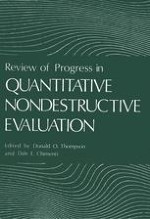1983 | OriginalPaper | Chapter
Effects of Microstructure on the Speed and Attenuation of Elastic Waves: Formal Theory and Simple Approximations
Authors : J. E. Gubernatis, E. Domany
Published in: Review of Progress in Quantitative Nondestructive Evaluation
Publisher: Springer US
Included in: Professional Book Archive
Activate our intelligent search to find suitable subject content or patents.
Select sections of text to find matching patents with Artificial Intelligence. powered by
Select sections of text to find additional relevant content using AI-assisted search. powered by
The sensitivity of the propagation of an elastic wave to changes in the microstructural details of a material is well known.1 In particular, numerous experiments have shown that the attenuation of the wave is sensitive to the inclusions, voids, cracks, grain boundaries, twin boundaries, interphase boundaries, magnetic domain walls, dislocations, substitutional impurities of a material. For attenuation studies in metals, ceramics and polycrystals, three formulas, each for different wavelength regimes, are generally used in the quantitative interpretation of experimental results.1–3 If λ is the wavelength of the elastic wave and <D> is the average grain diameter, then in the Rayleigh regime (λ≫D), α = A1<D>3λ4, in the stochastic regime (λ≃D), α = A2<D>λ2, and in the diffusive regime (λ≪D), α = A3/<D>-1. By fitting the data to these formulas, one tries to infer <D>.
